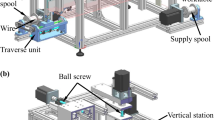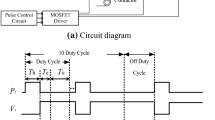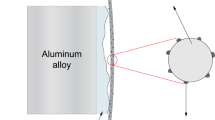Abstract
Diamond is a typical super-hard material with very high thermal conductivity. This makes is highly suited to heat dissipation from electronic microchips. The stability of its chemical lattice structure, however, means it has no free-electrons and a high melting point, making machining of diamond difficult. In this study, a micro-energy w-EDM (wire-Electric Discharge Machining) power source with dual-capacitance is designed for using high-frequency spark erosion to precisely cut boron-doped nano-polycrystalline diamond (B-NPD) material. The power source design consists of a dual-capacitance circuit, a programmable logic circuit (PLC), and a metal–oxide–semiconductor field-effect transistor (MOSFET). By utilizing a high-frequency switching dual-capacitance circuit, each capacitor has enough charge/discharge time to create a micro-energy pulse train of uniform iso-pulse on-time (τon) and iso-pulse peak current (Ip). Material removal occurs rapidly so that micro-quantities of diamond are readily removed to reduce the probability of thermal damage and graphitization. The technique allowed successful machining of a highly consistent plate-finned diamond heat-sink array and trapezoid-pillar diamond heat-sink array. Furthermore, manufacturing using the designed low-energy power-source is highly efficient. To estimate machining efficiency in terms of the content of charge per unit volume per unit of time in diamond cutting, “Charge Density (CD)” is proposed and examined as an evaluation criterion. The following are all discussed in detail: work frequency, work capacitance, wire-electrode number and short-circuiting percentage, heat-erosion on fins of different thicknesses, and fin efficiency.















Similar content being viewed by others
Abbreviations
- Af :
-
Total heat transfer area
- A0 :
-
Heat transfer area on heat-sink bottom
- C:
-
Work capacitance
- CD:
-
Charge density
- Cp :
-
Specific heat capacity
- Df :
-
Duty factor
- dpitch :
-
Top distance between features
- F:
-
Wire tension
- Fd :
-
Wire offset distance
- Fr :
-
Wire-electrode feed-rate
- f:
-
Work frequency
- G:
-
Spark erosion gap
- h:
-
Convection heat transfer coefficient
- I:
-
Current
- Ip :
-
Iso-pulse peak current
- K:
-
Thermal diffusivity
- k:
-
Thermal conductivity
- L:
-
Total cutting length
- MBR:
-
Material burning rate
- MRR:
-
Material removal rate
- MRA:
-
Material removal ability
- PCT:
-
Predetermined cutting time
- PSC:
-
Percentage by short-circuiting
- PSCAW :
-
Percentage by A-wire short-circuiting (%)
- PSCBW :
-
Percentage by B-wire short-circuiting (%)
- PSCABW :
-
Percentage by AB-wire short-circuiting (%)
- PSCtotal :
-
Percentage by total short-circuiting (%)
- Q:
-
Electric charge (coulomb)
- \(\dot{Q} {_{fin}}\) :
-
Heat transfer rate in single heat-sink
- \(\dot{Q} {_{0}}\) :
-
Heat transfer rate on heat-sink bottom
- \(\dot{Q} {_{total}}\) :
-
Total heat transfer rate
- R:
-
Circuit resistance
- Rbot :
-
Bottom circular of feature
- RCT:
-
Real cutting time
- Rmax :
-
Maximum roughness
- Rw :
-
Radius of wire-electrode
- SCPDW :
-
Probability of short-circuiting in dual-wire
- Tbot :
-
Bottom distance between features
- tc :
-
Cutting time
- Tdual-wire :
-
Time of single-slot cutting in dual-wire regime
- tm :
-
Workpiece thickness
- tmra :
-
Unit of time
- Tsingle-wire :
-
Time of single-slot cutting in single-wire regime
- ttop :
-
Top-width of microfeature
- u:
-
Temperature
- V:
-
Work voltage
- VR :
-
Real-time voltage
- VC :
-
Comparison voltage
- Vr :
-
Wire running speed
- Vol:
-
Material removal volume
- W:
-
Slot-width
- Ws :
-
Accumulated energy
- ρ⋅Cp :
-
Heat capacity
- τ:
-
Elapsed time
- τn :
-
Charge time
- τp :
-
Pulse on-time
- τon :
-
Iso-pulse on-time
- τr :
-
Pulse off-time
- ηfin :
-
Fin efficiency
- θ0 :
-
Difference in temperature
References
Lee, Y. L., Jeong, S. T., & Park, S. J. (2014). Study on manufacturing of recycled SiC powder from solar wafering sludge and its application. International Journal of Precision Engineering and Manufacturing-Green Technology, 1, 299–304.
Demazeau, G. (1995). High pressure diamond and cubic boron nitride synthesis. Diamond and Related Materials, 4, 284–287.
Odake, S., Ohfuji, H., Okuchi, T., Kagi, H., Sumiya, H., & Irifune, T. (2009). Pulsed laser processing of nano-polycrystalline diamond: A comparative study with single crystal diamond. Diamond and Related Materials, 18, 877–880.
Tong, X. C. (2011). Advanced materials for thermal management of electronic packaging (pp. 283–186). New York: Springer.
Zhang, R. J., Lee, S. T., & Lam, Y. W. (1996). Characterization of heavily boron-doped diamond films. Diamond and Related Materials, 5, 1288–1294.
Sumiya, H., Ikeda, K., Arimoto, K., & Harano, K. (2016). High wear-resistance characteristic of boron-doped nano-polycrystalline diamond on optical glass. Diamond and Related Materials, 70, 7–11.
FACT abrasives Taiwan Co. LTD. (2020). http://www.factdiamond.com.
Wood, J. (2014). Behavioral modeling and linearization of RF power amplifiers (pp. 142–145). Boston: Artech House.
Chen, S. T., & Chen, C. H. (2017). Development of a novel micro w-EDM power source with a multiple Resistor-Capacitor (mRC) relaxation circuit for machining high melting point, -hardness and -resistance materials. Journal of Materials Processing Technology, 240, 370–381.
Yang, Z., Zhang, S., Hu, J., Zhang, Z., Li, K., & Zhao, B. (2020). Study of material removal behavior during laser-assisted ultrasonic dressing of diamond wheel. International Journal of Precision Engineering and Manufacturing-Green Technology, 7, 173–184.
Wu, J., Liu, T., Chen, H., Li, F., Wei, H., & Zhang, Y. (2019). Simulation of laser attenuation and heat transport during direct metal deposition considering beam profile. Journal of Materials Processing Technology, 270, 92–105.
Riveiro, A., Quintero, F., Boutinguiza, M., Val, J. D., Comesaña, R., & Lusquiños, P. J. (2019). Laser cutting: a review on the influence of assist gas. Materials, 12, 157.
Kim, K., & Yun, K. S. (2019). Stretchable power-generating sensor array in textile structure using piezoelectric functional threads with hemispherical dome structures. International Journal of Precision Engineering and Manufacturing-Green Technology, 6, 699–710.
Valenzuela, J.A., Hanover, N.H. (1995). Inductor-charged electric discharge machining power supply. U.S. Patent US5399825.
Koyano, T., & Kunieda, M. (2010). Achieving high accuracy and high removal rate in micro-EDM by electrostatic induction feeding method. CIRP Annals-Manufacturing Technology, 59, 219–222.
Chung, D. K., & Chu, C. N. (2015). Effect of inductance in micro EDM using high frequency bipolar pulse generator. International Journal of Precision Engineering and Manufacturing-Green Technology, 2, 299–303.
Maradia, U., Knaak, R., Dal Busco, W., Boccadoro, M., & Wegener, K. (2015). A strategy for low electrode wear in meso–micro-EDM. Precision Engineering, 42, 302–310.
Koyano, T., Sugata, Y., Hosokawa, A., & Furumoto, T. (2017). Micro electrical discharge machining using high electric resistance electrodes. Precision Engineering, 47, 480–486.
Sommer, C. (2000). Non-traditional machining handbook (pp. 117–124). Advance Publishing.
Bishop, O. (2011). Electronics - circuits and systems, 4th Edition. Elsevier Ltd., pp. 31–38.
Chen, S. T., & Yang, S. W. (2017). A high-density, super-high-aspect-ratio microprobe array realized by high-frequency vibration assisted inverse micro w-EDM. Journal of Materials Processing Technology, 250, 144–155.
Chen, S. T., & Jhou, W. Y. (2021). Dual-crankshaft out-of-phase balanced drive mechanism applied to high-frequency scraping of high-density microcavities patterns. International Journal of Precision Engineering and Manufacturing-Green Technology, 8(4), 1163–1180.
Non-contact wire array tension control device, US patent 10857609 B2 (2018).
Macedo, F. T. B., Wiessner, M., Hollenstein, C., Martendal, C. P., Kuster, F., & Wegener, K. (2019). Anode power deposition in dry EDM. International Journal of Precision Engineering and Manufacturing-Green Technology, 6, 197–210.
Chen, S. T., Chen, C. C., & Shih, S. Y. (2021). Efficient microspark erosion-assisted machining of a monocrystalline microdiamond stylus using a heat-avoidance path. Precision Engineering, 72, 426–436.
Hirao, A., Gotoh, H., & Tani, T. (2018). Some effects on EDM characteristics by assisted ultrasonic vibration of the tool electrode. Procedia CIRP, 68, 76–80.
Cengel, Y. A., & Ghajar, A. J. (2010). Heat and mass transfer: fundamentals & applications (4th ed., pp. 23–172). New York: McGraw-Hill.
Reznik, A., Richter, V., & Kalish, R. (1998). The re-arrangement of broken bonds in damaged diamond: Graphitization versus annealing back to diamond. Diamond and Related Materials, 7, 317–321.
Bigot, S., D’Urso, G., Pernot, J. P., Merla, C., & Surleraux, A. (2016). Estimating the energy repartition in micro electrical discharge machining. Precision Engineering, 43, 479–485.
Liang, J., Nakamura, Y., Zhan, T., Ohno, Y., Shimizu, Y., Katayama, K., Watanabe, T., Yoshida, H., Nagai, Y., Wang, H., Kasu, M., & Shigekawa, N. (2021). Fabrication of high-quality GaAs/diamond heterointerface for thermal management applications. Diamond and Related Materials, 111, 108207.
Zhao, D., Zha, S., & Liu, D. (2021). Influence of sputtering and electroless plating of Cr/Cu dual-layer structure on thermal conductivity of diamond/copper composites. Diamond and Related Materials, 115, 108296.
Acknowledgements
The authors would like to thank the Ministry of Science and Technology of the Republic of China, Taiwan for financially supporting this research under Contract No. MOST 108-2221-E-003-012-. A portion of the work is supported by Messrs. Tsai S.K., Shen M.H. and Xiao X.J. in National Taipei University of Technology. Their assistance is gratefully acknowledged.
Author information
Authors and Affiliations
Corresponding author
Additional information
Publisher's Note
Springer Nature remains neutral with regard to jurisdictional claims in published maps and institutional affiliations.
Rights and permissions
About this article
Cite this article
Chen, ST., Huang, LW. A Micro-energy w-EDM Power Source Based on High-frequency Spark Erosion for Making Diamond Heat-Sink Arrays. Int. J. of Precis. Eng. and Manuf.-Green Tech. 9, 1267–1283 (2022). https://doi.org/10.1007/s40684-021-00396-7
Received:
Revised:
Accepted:
Published:
Issue Date:
DOI: https://doi.org/10.1007/s40684-021-00396-7




